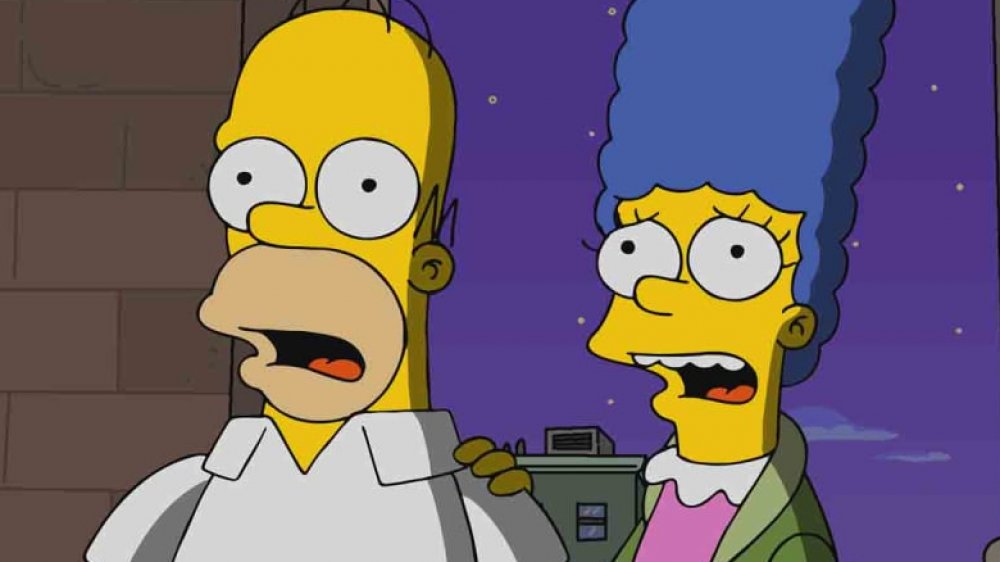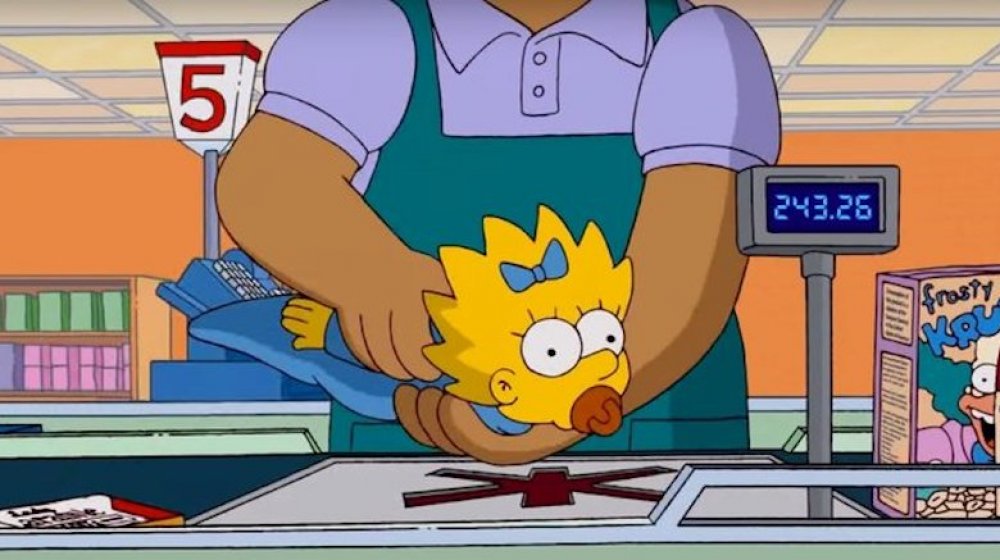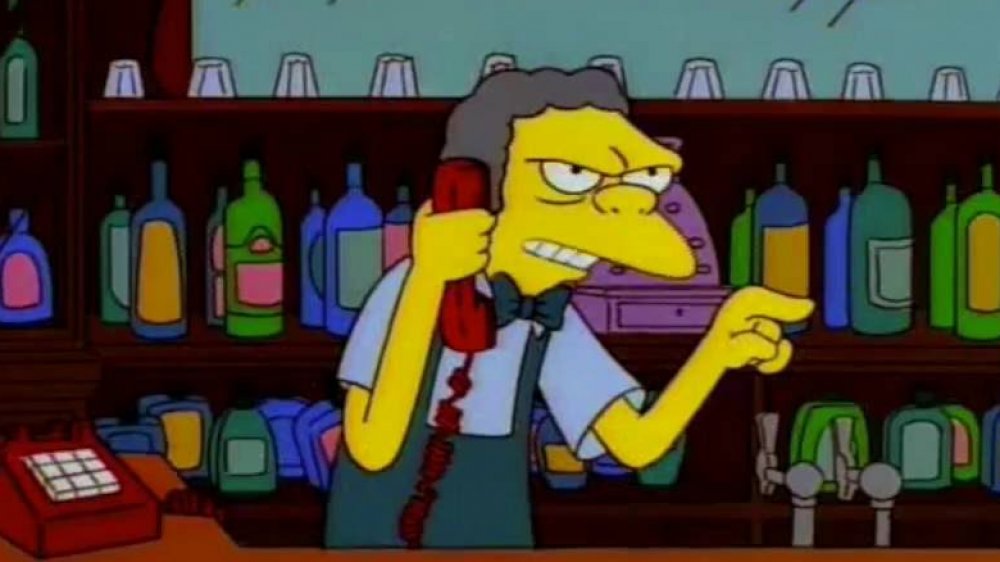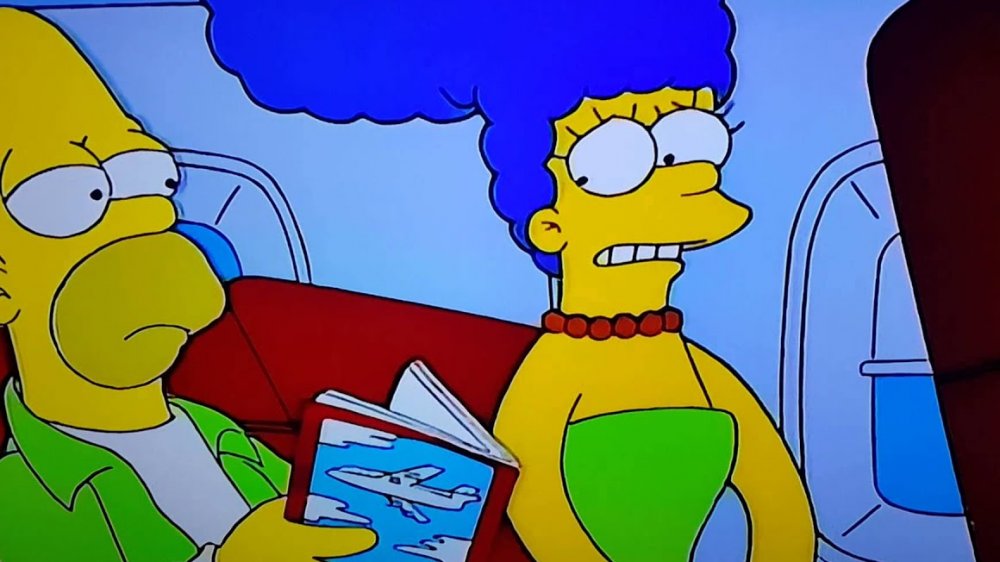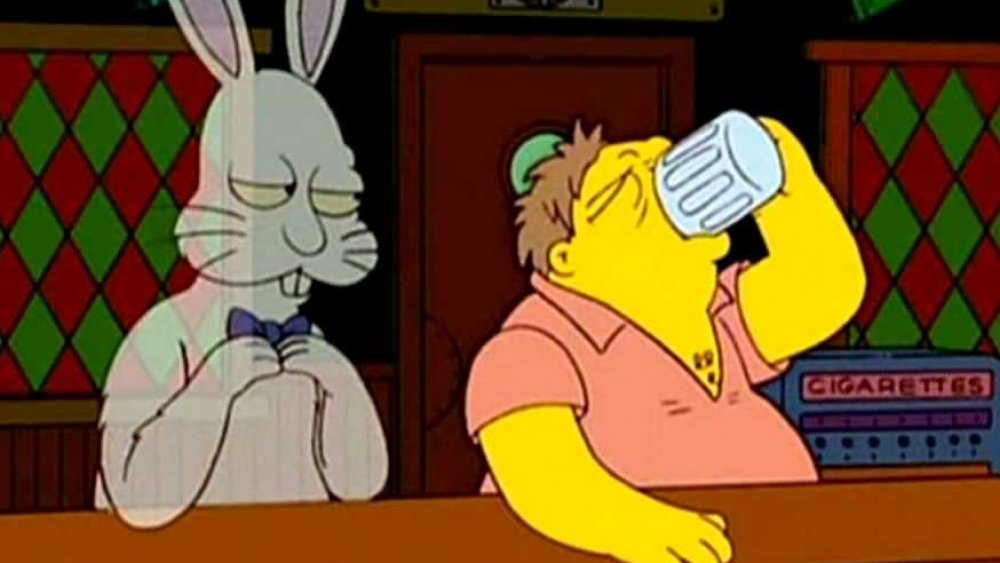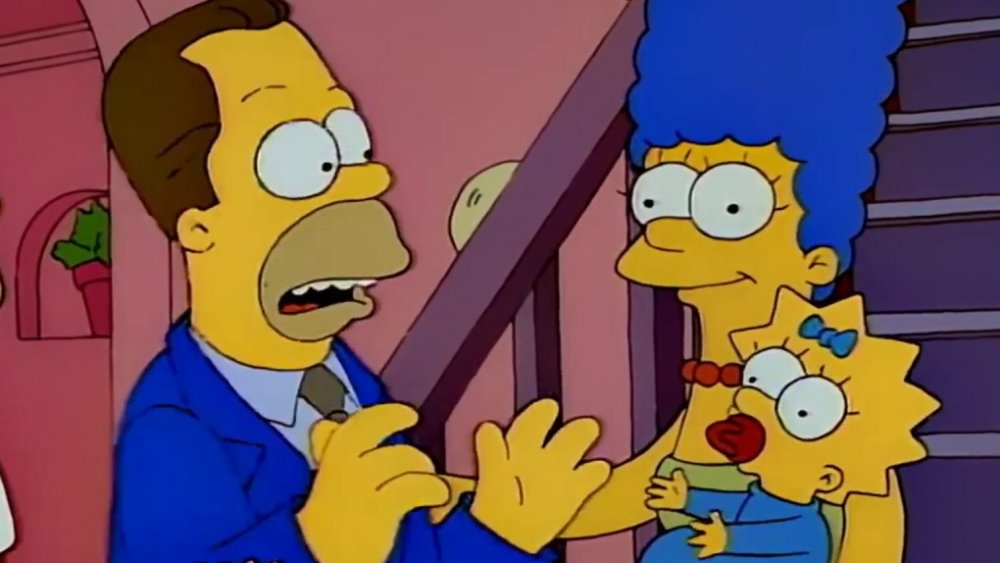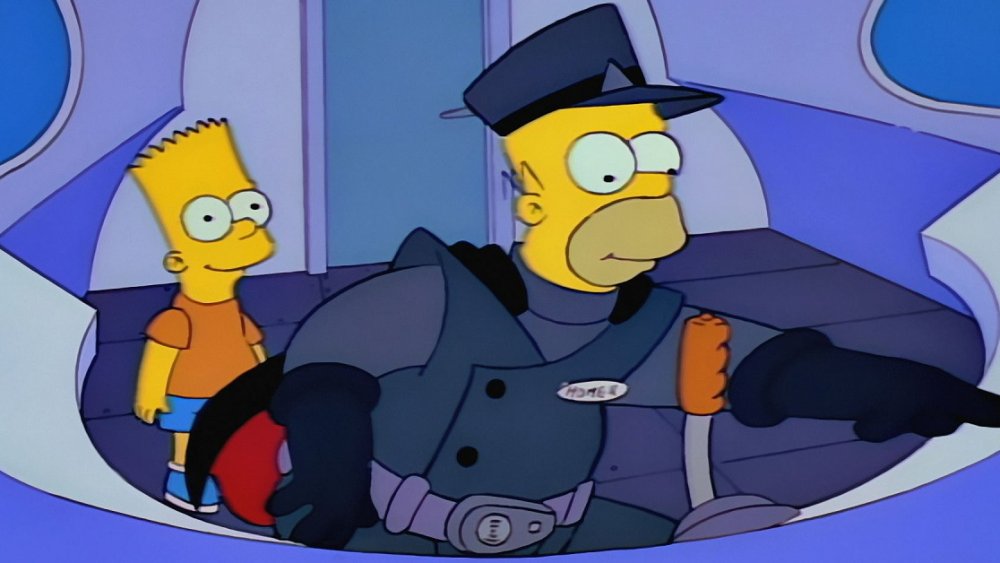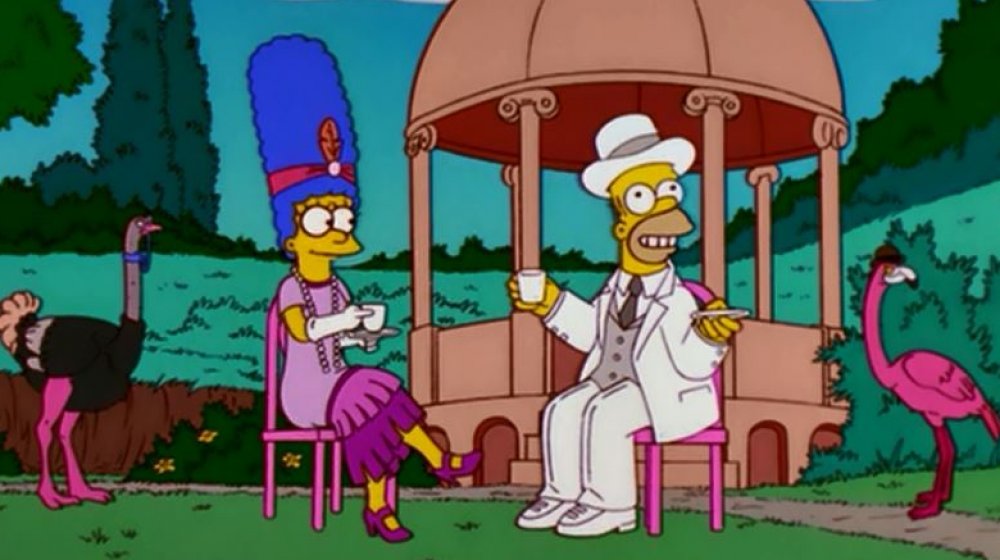The Biggest Unanswered Questions In The Simpsons
The Simpsons isn't subject to the regular rules of television. Characters don't age, Springfield can be geographically placed anywhere the plot needs it to be, and stories can get as big and wild as the writers want. Why? Because animation can make things happen that would be way too expensive and complicated on a weekly, live-action, network TV series. Because of these factors and more, The Simpsons is also an extremely vast series, with brand new parts of Springfield still being introduced 30 years on and with a cast that's ballooned to include hundreds of named characters.
With that kind of scope and volume, there are a lot of stories to tell, a lot of angles to take care of, and much to resolve each week before moving on to the next adventure. But the show's main goal is to make jokes and entertain in episodic fashion. And because it isn't serialized, a lot of plots and fates are left dangling, never to be resolved. And today, we're looking at some of those incredibly strange head-scratchers. Here are some big questions that The Simpsons has posed over the years, which it never fully answered.
The Simpsons' opening credits sequence is full of questions
The Simpsons has been on so long that its opening sequence has become ingrained in the public consciousness. With more than 600 episodes aired, most Simpsons fans could probably recall some, if not all of it from memory. Among the big moments, which all lead to the Simpson family meeting on their couch, we've got Bart writing a message on a classroom blackboard wall a few dozens times as punishment, Lisa getting kicked out of band practice for playing jazz, Maggie getting picked up with Marge's groceries and swiped across a cashier's barcode scanner, and Homer cutting out of work when he hears the whistle blow, carelessly allowing a nuclear rod to bounce around after him.
Not one of these events is free of the need for inspection. Bart abandons the chalkboard when he hears a school bell ring, but why does a bell ring when this is obviously his after-school punishment? And why is Lisa's band class, often depicted as part of her regular school day, being held after class? Plus, these events suggest that it's about three or four o'clock, which seems early for Homer's nine-to-five gig to end. As for Maggie getting scanned, a price pops up for the grocery cashier, meaning Maggie is seemingly wearing a barcode somewhere on her person. What's up with that?
How does Moe not realize the prank caller is Bart Simpson?
One running gag in The Simpsons, most prominent in the early years of the show, wasn't only a hilarious triumph of semi-profane wordplay, but it characterized Bart Simpson as a rude, cynical troublemaker. The boy would often call up Moe's Tavern and ask to speak with someone, and he'd always give a made-up name that, when said aloud, formed a hilarious expression — Bea O'Problem or Mike Rotch, for example. Moe would then dutifully call out to the assorted barflies, "Do I have a Bea O'Problem," or, "Has anybody has seen Mike Rotch?"
Bart (and usually Lisa) would then descend into a fit of giggles, and realizing he'd been pranked yet again, Moe would threaten a horrific and explicitly detailed act of violence against the caller, should he ever figure out who he is. By this point, Moe should've and could've murdered Bart a dozen times over because it's inexplicable that he hasn't realized his frequent prank caller is the eldest Simpson child. Bart's father is one of Moe's best customers, and they're very close. Moe is a family friend of the Simpsons, and he's met, spoken to, and even traveled with Bart on a number of occasions. So unless there's something wrong with Moe's hearing, we're not really sure what's happening with this guy.
How old is Mr. Burns?
C. Montgomery Burns — the town villain who owns the Springfield Nuclear Power Plant and who once blocked out the sun — is incredibly old, something which Simpsons writers never fail to exploit for laughs. He's fond of using insults with an old-timey insults like "dunderpate," answers the phone by saying "ahoy, ahoy" (based on a greeting advocated by telephone inventor Alexander Graham Bell in the 1800s), and tries to stack his company's softball team with players who've been dead for a century.
Burns' advanced age is clearly just a vehicle for jokes and hilariously archaic words, but it does make for a confusing situation when trying to determine the character's precise vintage. His birth year has been given as both 1881 and 1890, making him at least 100 in the realm of The Simpsons (where time doesn't pass). But in the 1993 episode "Last Exit to Springfield," there's a flashback to Burns as a boy in 1909 visiting an atom-smashing mill, and he appears to be about elementary school age, placing his birth around 1900. And in the episode "Simpson and Delilah," Burns' age is said to be 81, although in a few other episodes, that age changes to 104. Crazier still, in "Fraudcast News," he claims to have been 89 "for a while now." And when Springfield's oldest man dies at age 108, Burns takes his place. He could even be older, as Burns' ATM password is four digits long ... just like his age.
Isn't Marge afraid to fly?
In the sixth season episode "Fear of Flying," Homer is rewarded for helping an airline hide its gross negligence with planet tickets for the whole family. However, they don't ever make a trip because Marge suffers a major anxiety attack while awaiting takeoff. So they get off the plane, and at Lisa's suggestion, Marge sees a psychiatrist to find the cause of (and cure) her fear of flying. A repressed memory reveals that Marge hates flying because when she was very young, she found out her father was secretly a flight attendant or "male stewardess." And now, having triumphed over her fear, Marge gets on a plane with the family ... only for it to run off the runaway and crash into a lake.
That implies Marge's deep discomfort with flying remains both intact and justified, something which doesn't mesh with events in later seasons. The Simpson family goes on to take multiple, semi-frequent vacations and trips via airplane, Marge included, who never seems to be anything but totally comfortable and totally relaxed before and during her air voyages. At some point then, did Marge return to therapy and find the mental solace she needed?
When did Barney start drinking again?
A permanent fixture at Moe's Tavern (when he isn't lying in the gutter after a bender, that is), Barney Gumble is seemingly always inebriated or in the process of getting inebriated. Barney's obvious alcoholism is a dark but frequent source of comedy. He once won the Springfield Film Festival with his beautiful and haunting movie about his battle with the bottle, and viewers learned that he had a promising future until Homer gave him his first beer the night before the SATs, setting Barney on a drunken path.
However, in the poignant 2000 episode "Days of Wine and D'oh'ses," Barney swears off beer, joins Alcoholics Anonymous, and adjusts to a life in recovery. However, his addictive tendencies run deep. He still hangs out at Moe's all the time because the bartender buys an espresso machine, and Barney replaces his dependency on alcohol to caffeine. For many seasons, a well-groomed Barney is shown drinking latte after latte (including a couple of minor relapses when he drinks a beer or two) until one day Barney is once more permanently a slob knocking back brewskies. So what exactly led Barney to fall off the wagon and why? Unfortunately, we haven't gotten an answer yet.
Where's the baby translator? And Homer's chair?
A lot of famous people have shown up on The Simpsons, and Danny DeVito guest-voiced as Homer's estranged half-brother, Herbert Powell, on two early episodes. In "Oh Brother, Where Art Thou?," he's a successful car company owner who lets Homer design a car that's such a flop it destroys the company and leaves him destitute. After being homeless for a while, Herb returns in "Brother, Can You Spare Two Dimes?" and stays with the Simpson family for a while, until he can get back on his feet.
Then, with young Maggie's help, Herb develops a baby translator, and it's an instant success that makes him wildly rich once more. To show his appreciation, he buys Homer the expensive luxury recliner he's had his eye on. Now, the plot of this episode hinges and ends on two very important objects — a device that unlocks the language of pre-verbal infants to let parents know what their babies are saying and a huge piece of furniture. But the impact or presence of these two objects is never again addressed or felt on The Simpsons. A baby translator would change the world, yet nobody in the the show has one, not even the Simpson family. As for the chair, hundreds of scenes have been shot in the Simpsons' TV room, with Homer firmly planted in the couch and not his fancy chair. In fact, we never see that chair again.
There are a lot of monorail questions on The Simpsons
The Springfield Monorail seemed like such a futuristic and progressive idea. It even had a catchy song, introduced by monorail proprietor Lyle Lanley, which assuaged the fears of the people of Springfield, convincing them to give Lanley the cash windfall collected from fining Mr. Burns for crimes against the environment. Of course, the monorail was a civic, financial, and political disaster.
But strangely enough, no ramifications or fallout ever seemed to transpire. Not only is Main Street still all cracked and broken, as a dubious Marge pointed out in "The Monorail Song," but the town was left in far worse shape when a makeshift anchor to stop the runaway monorail ripped through several streets and buildings. Did Springfield fix all those roads, and if so, how did the cash-strapped town pay for it? And on that note, are the monorail towers, tracks, and trains still hanging around Springfield?
There's also the whereabouts of Lyle Lanley to consider. He built the monorail dirt cheap and then absconded with the rest of the cash, only for his getaway plane to perform an emergency landing in another town he victimized, where an angry mob confronted him. It's possible those townsfolk killed him right then and there with their pitchforks, but then, they might've just thrown him in jail on charges of criminal negligence.
Does Hank Scorpio still run things?
"You Only Move Twice" finds the Simpson family saying "so long, Stinktown" to Springfield in favor of a perfect, upscale community called Cypress Creek. It's a bedroom community for the employees of the Globex Corporation, where Homer has taken a well-paying supervisor position. His boss is a charismatic, fast-talking industrialist named Hank Scorpio, who at first seems like an eccentric Silicon Valley CEO but whom viewers (but never Homer) realize is actually a power-mad archvillain bent on world domination. (At one point, he tries to kill a James Bond-like figure, who gets away, only for Homer to stop him and pass him off to goons.)
With the rest of the family desperately missing Springfield, Homer sadly resigns to Hank Scorpio, right in the middle of a violent standoff. And at the end of the episode, a copy of the Springfield Shopper bears Scorpio's picture along with the headline "Supervillain Seizes East Coast." So for all we know, Scorpio still has authority over this very important and populous part of the United States. It seems like the series might want to address the dictator who's taken over a chunk of America, but so far, we have no idea what's going on with this dude.
What's up with the island on The Simpsons?
The 2000 episode "The Computer Wore Menace Shoes" is undoubtedly one of the weirdest installments of The Simpsons. Homer starts a website and spreads rumors and conspiracy theories — most of which he made up — until he accidentally gets one right. When he inadvertently tells the public that flu shots are performed just before Christmas to incite the mass urge to shop, he's sent to a strange, spooky, and surreal island prison. Among the occupants, there's a man who invented a bottomless peanut bag, Homer's German-speaking doppelgänger, and a bunch of menacing bubbles.
Homer manages to escape and return home, only to be greeted by Santa's Little Helper who sprays gas at him and the rest of the family ...who then wake up in a state of drugged-out bliss on the island. And then the scene fades to black, and the credits roll. The penal island is a lengthy tribute to the bizarre 1960s British TV series The Prisoner, but this episode isn't established as non-canonical like the many Simpsons "Treehouse of Horror" segments. For all viewers know, the "real" Simpsons are still on that island.
Unanswered questions about Troy McClure and Lionel Hutz
The Simpsons has been on the air for 30 years now, and as time marches on, people pass away. Several longtime voice actors on the series have died, including Marcia Wallace (as Springfield Elementary teacher Edna Krabappel) and Russi Taylor (twins Sherri and Terri and brown-nosing nerd Martin Prince). As a result, Simpsons writers have approached how to handle the characters left behind by deceased cast members in different ways. When Wallace died, middle-aged Mrs. Krabappel died, too, and her death was noticed and mourned, in particular by her husband, Ned Flanders. When Taylor passed on, her child characters survived, voiced by new cast member Grey DeLisle-Griffin in her stead.
Of course, the first big death on The Simpsons came when Phil Hartman was shockingly murdered in 1998. Producers opted to instantly retire his recurring characters, washed-up B-movie actor Troy McClure and hapless Simpson family attorney Lionel Hutz. Writers simply didn't include the characters anymore, and neither was ever mentioned again. Unlike Mrs. Krabappel, whose death was a major plot point, two prominent Springfieldians were never given a proper send-off, nor was a reason for either's departure ever given. So while we know what happened to poor Hartman, the fates of these characters has never been discussed.
How did Springfield's immigrant population return?
The 1996 episode "Much Apu About Nothing" takes on the political hot-button issue of immigration, or rather how politicians blame government shortfalls on illegal immigrants supposedly bleeding the system dry. In Springfield, this transpires when a "bear patrol" leads to a tiny tax increase, which upsets the citizenry so much that Mayor Quimby blames the new tax on immigrants. Voters then decide on Proposition 24, which will immediately deport every illegal immigrant living in Springfield.
In fear of the measure passing, Kwik-E-Mart proprietor Apu frantically studies for the citizenship test and passes. Bartender Moe (in disguise) is also shown taking the test, as is stereotypical Italian chef Luigi. Apu passes, and Moe and Luigi presumably do, too, as both remain in town when Prop 24 passes in a landslide. However, the episode ends with a resentful Groundskeeper Willie on a boat — dressed in the style of a 19th-century European arriving at Ellis Island — sailing away from Springfield. He then remarks, "I'll be back."
True to his word, he is back, but it's unclear how he was able to return to town and his job so quickly and easily. It's not clear if he took a citizenship test or arranged for a legal immigration, or if he somehow snuck back into Springfield from Scotland.
How do the residents of Springfield live with all that pollution?
The Simpsons has always been a satirical show, holding an animated mirror up to society to point out ills and make fun of them. Some subjects may change with the episode, but one target ingrained into the show's DNA is definitely big corporations who do bad things.
After all, Homer Simpson works for the Springfield Nuclear Power Plant, where skirting environmental law in the name of more profits for owner Mr. Burns is a regular occurrence. As a result, Springfield is a massively polluted and politically corrupt wasteland, where the power plant can dump toxic waste almost wherever and whenever it wants to, while the local government does little more than assess the occasional fine that doesn't hurt the wildly wealthy Burns. In fact, the town's ill-fated monorail is built with funds from the $3 million Burns was charged after being caught dumping poisonous muck. And one of the show's earliest efforts finds his gubernatorial campaign sidelined by a three-eyed fish caught in a waterway polluted with waste.
Toxic pollution is just a part of life in Springfield, and it makes a viewer wonder — is exposure to chemicals why all the residents have sickly yellow skin, bulging eyes, and four fingers on each hand? Is it why they don't seem to age in a normal way? There certainly have to be even more ways that nuclear waste has profoundly altered the lives of Springfieldians, and we're just waiting for The Simpsons to answer those burning questions.
